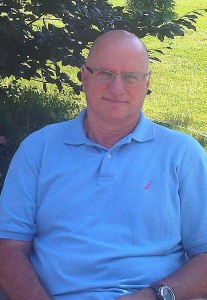 FRANK SORIANO has been happily married for twenty years and has two children — a son, sixteen, and a daughter, fourteen. For thirty years he was employed by a government agency, and he spent the last ten years of his career as a leadership consultant. He was recently released (happily) from indenture and is now a freelance consultant specializing in leadership development, team building, and communication.
FRANK SORIANO has been happily married for twenty years and has two children — a son, sixteen, and a daughter, fourteen. For thirty years he was employed by a government agency, and he spent the last ten years of his career as a leadership consultant. He was recently released (happily) from indenture and is now a freelance consultant specializing in leadership development, team building, and communication.
Frank participated in Allyson’s June 2010 memoir writing workshop organized by professional keynote speaker Nina Spencer at Verity club in downtown Toronto, Canada.
* * *
Here are my seven treasures:
1.
Let me tell you what I did during my summers from the ages of 12 to 20. I went to Camp Soriano, and in retrospect, I realize that made me one of the luckiest kids in the world.
I would get up at 6:30 a.m. and eat breakfast and then catch a ride with my father to his store, where he made custom-made orthopedic shoes and operated a shoe repair shop. Over the course of eight summers, I learned to shine shoes, and replace heels and soles. I also used a Singer sewing machine to repair purses, handbags, shoes, and anything else that needed stitching. That Singer was black cast iron, and incredibly heavy, and it operated with a foot pedal.
I remember asking my father to teach me how to make shoes so I could help him more with his work. He would smile at me and show me his hands, dark with black ink, callused, and wounded, and say to me, “I don’t want your hands to look like mine. Go to school and get an education.”
I still have the sewing machine, which I saved when my father sold his business. I haven’t used it for close to fifty years, but I’m willing to bet that I can still operate it. My mother refers to it as a dust collector, and my wife thinks of it as more junk in the basement.
To me it is so much more.
2.
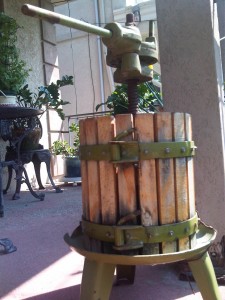
Miniature wine press
This is a story my father loved to tell.
He was brought up in a small village in Italy, near Naples. When he was three years old, my grandfather would put two glasses in front of him at the dinner table, one filled with wine, the other with a blend of water and wine. My grandfather would ask my father to tell him which glass was just wine.
After tasting some from each glass, Dad always picked the right glass. This, according to my father, was how at an early age he developed his taste for wine.
After moving to Canada, as soon as he was able to, he bought himself all the necessary equipment, including il torcio, the wine press. He prided himself on making a fine wine, a process he had learned back in the old country from his father.
Every fall, usually in the second week of October, we would set off to buy cases of grapes — specific brands, in specific quantities, to ensure the “right” mix for his treasured wine. There was also a “process” and we were not to deviate from that process.
Grapes were purchased on a Wednesday night, broken up using a machine for that purpose, and left to ferment in the barrel for three days. After dinner on Saturday night, we put the grapes in the wine press to squeeze all the juice out of them, a procedure that went on all night. Grape juice flowed from the wine press, and regardless of the impurities we would sample it and determine whether it was going to be a “fine wine year.”
The next morning, the wine was brought down into the cantina — the wine cellar — in gallon jugs and poured into a larger, 40-gallon glass container, where it was allowed to ferment for a short period of time. And all the grape remnants were removed from the equipment, which was washed and stored away until the following year.
As his health failed, my father realized he wouldn’t be making wine anymore and he wanted me to sell the wine press. I just couldn’t. It takes me back to my childhood, and a special time that I shared with him. I never saw my father look happier than when he was engaged in this yearly ritual, learned from his father and handed down to me.
The truth is, I haven’t made wine since my father passed away a number of years ago, so for now, the wine press sits in a corner of the garage. One day it may be used once again. I’d better be sure not to deviate from the process.
3.
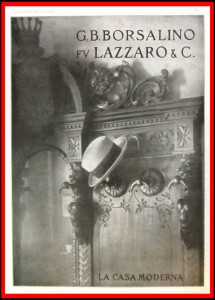 When my father first arrived in Canada from Italy, in 1948, suits for men were double-breasted with pointed wide lapels and big buttons. Trousers were pleated with cuffs. And ties were wide. Every man owned and wore an Italian Borsalino hat, a fedora as it’s known here. It was made famous by Al Capone, and later Humphrey Bogart and Indiana Jones. And now Justin Timberlake wears one.
When my father first arrived in Canada from Italy, in 1948, suits for men were double-breasted with pointed wide lapels and big buttons. Trousers were pleated with cuffs. And ties were wide. Every man owned and wore an Italian Borsalino hat, a fedora as it’s known here. It was made famous by Al Capone, and later Humphrey Bogart and Indiana Jones. And now Justin Timberlake wears one.
In my dad’s day it was a “must have.” Back then, cars were built such that you could actually wear a hat like that while driving.
I suppose I’d always been fascinated with them, and thirty years ago, I purchased a Borsalino hat for myself. It’s navy blue with a wide band. I like the look of it: the wide brim, the peak. When I wear it, people comment on how great it looks and how more men should wear them.
To me the hat is symbolic of a different time and place, glamorized but fascinating. You know — Al Capone, Elliot Ness, and the Roaring Twenties. I still wear that Borsalino hat, especially when the weather is cold.
4.
I met Bubbi Ida in 1976, and over the years I spent many an evening talking to her on her front porch about the nature of life and our existence. Later, my kids adopted this remarkable woman as their Jewish grandmother.
While visiting Venice in the early 1960s, she had purchased a marble figurine of a charioteer reining in two muscular horses. She told me she had carried that figurine in her hands all the way back from Italy to make sure nothing happened to it. The sculpture is a work of stunning craftsmanship, and I have always admired its detail and the sense of power it projects.
In her later years, when Bubbi was giving up some of her treasured possessions, she asked me to take care of the figurine for her. Now one of my treasures, it sits proudly on my fireplace mantel.
I’ll be forever grateful that for the past forty years of my life I had the good fortune to know Bubbi Ida. The charioteer and his horses remind me of this woman who exemplified wisdom, compassion, understanding, generosity, and kindness.
5.
I can’t remember a day that I didn’t enjoy going to school, and part of my joy came from playing defensive tackle for the York Memo Mustangs.
I still have my football jersey, ripped and torn, evidence of some meaningful collisions and tackles on the field. Over the years I have stitched it up repeatedly and my kids have had fun wearing it to school for “theme” days.
As it happens, my daughter is a competitive swimmer, part of the York Swim Club. The club uses Centennial Pool, which is connected to my old high school and was completed when I was in Grade 11. Days when I go to pick her up, I make my way to the back of the school and walk toward the football field. The running track has been neglected and is overgrown with weeds, but the football field is still used by students there.
As I can stand there I can almost see my team playing against our rivals, and I am reminded of the many happy days I spent in high school, and why I treasure that red and gold football jersey, number 82.
6.
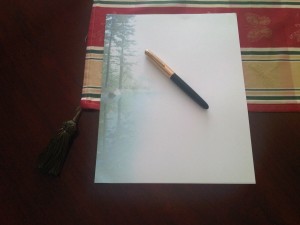 When my parents got engaged in the late 1940s, my father presented my mother with an engagement ring and she reciprocated by giving him a matching set of Parker pens, black with gold caps. One was a fountain pen and the other a mechanical pencil. My father loved to write, especially to his sister in Italy.
When my parents got engaged in the late 1940s, my father presented my mother with an engagement ring and she reciprocated by giving him a matching set of Parker pens, black with gold caps. One was a fountain pen and the other a mechanical pencil. My father loved to write, especially to his sister in Italy.
Not a lot of people use fountain pens today, and there’s not much handwriting done either. But there is a singular beauty in the flow of a fountain pen that cannot be explained to anyone who hasn’t used one. Pens may be more advanced these days, but the fountain pen reminds me of a day when you would sit down and take the time to write a letter or note and would not be rushed.
I still have both pens and keep them safe, planning one day to pass them on to my son or daughter, a reminder of the grandfather they came to know and love.
7.
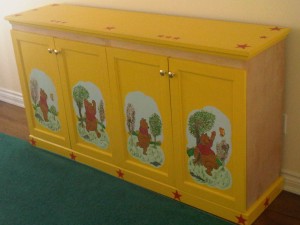 Like most parents with children, at some point we became overwhelmed with the number of toys and games the children had accumulated, many of them gifts from close friends and relatives. The problem is, where do you store them?
Like most parents with children, at some point we became overwhelmed with the number of toys and games the children had accumulated, many of them gifts from close friends and relatives. The problem is, where do you store them?
My wife suggested purchasing a cabinet from IKEA. “Over my dead body,” I said with my inside voice.
A carpenter wannabe, I told her I would build a wooden cabinet myself to store the toys. The cabinet would have stile-and-rail panels for the doors, Winnie-the-Pooh decorations, and two-tone paint. My wife thought that I was overreaching, but I was determined.
It took me six months’ worth of weekends and I learned as I went along, but I ended up building a six-foot cabinet, painted just as I’d visualized it, with more than enough room to store everything.
The kids still use the cabinet, though these days it’s for belongings other than toys. And when I look at it I know that I made something that they cherish as I do. I hope, too, that as a result they see me as someone who wasn’t afraid to try something I’d never done before, someone who was willing to learn through doing.
Maybe after they’ve left home, I’ll keep the cabinet for my own toys.
These are awesome memories. The repairing of shoes, making of vintage wine, the cabinet that you made for your children. Given the warm way you wrote these seven things, I wonder what seven your children will cherish from their time with you.
Heather, thanks for your kind remarks. First, if it weren’t for Allyson’s encouragement and guidance, I wouldn’t be writing at all, so thanks Allyson, for a gift that money cannot buy. Second, not sure what seven treasures my kids may have, but I hope to create enough different memories so they can at least have some choice. This is also a great subject for dinner conversation, assuming you have the right crowd.
I was lucky enough to have parents who put family above all else, and if I remember anything at all, it will be the time spent with my parents, doing all sorts of things. I hope my kids will be able to say the same. Best wishes. ciao.
Beautiful! Economical and very moving. The first three, in just a few words, evoke a whole lost world.
Elizabeth,
Thanks for your thoughts and kind words. Perhaps therein lies my dilemma. I miss the world I once knew, when things seemed much simpler to me. On the other hand, when I was a child, I thought as a child……………………who knows. In any case, I felt lucky then, and I feel very lucky now. I hope my luck continues. ciao.
Dear Frank,
I have known you for over 20 years now and you managed to have me in tears and in moments of laughter.
You have shared some of the stories with me in the past. However, the way in which you retell and describe the emotions and the senses you were feeling are quite powerful. I am looking forward to re-reading your seven treasures as there is such nostalgia for honoring the gifts your father left you and the hopes you have for your children.
Thank you Frank,
Josie
Thanks Josie, and it has been my good fortune to share tears (of joy, for the most part) and much laughter over the last 20 years with you. I am share over the next 20, 30 and 40 years (I hope) as our friendship continues to flourish, there will be more tears (of joy), laughter and many more stories to tell. Looking forward to it. Thanks again for your encouragement and most of all friendship. ciao.
Wasn’t sure it was you until I read the stories. Remember you talking about Camp Soriano during our lunches at York. Hope your children appreciate the stories! I loved listening to my father’s stories. I too have some of his “tools” that I cannot part with.
mr
As I sit here in Bobcaygeon, having my coffee, looking out over the lake and reading your
7 Treasures…I’m inspired…what a beautiful gift to your children, Frank.
This style of writing is a perfect platform for you, my friend~ a man of many words.
julie
Frank,
I figured if you were going to make my dinner at Turquoise Waters Writers’ Retreat, I should review what I’d read about you in this post. I can’t wait. Our group will have so much fun learning more about each other. Allyson is famous for bringing together an interesting mix.